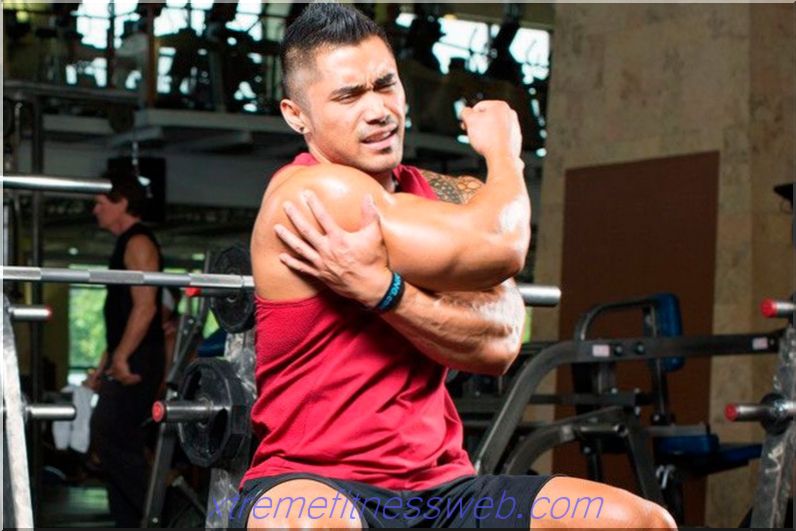
For people leading an active lifestyle and looking after themselves, the latest training system was developed, thanks to which, it turns out, to pay attention to each muscle group and achieve the desired results in a short time.
Three-day split is the latest development of training technique, thanks to it, it turns out, to compose all muscle groups so that the athlete manages to use every muscle of his body in one approach of exercises. Thanks to this, they group in time and begin to work. The main thing is the correct approach in this matter, and then the work of each muscle group will be built in the right way. To achieve this kind of results, you need to work hard and fulfill two simple conditions: pay attention during training to a small and large group of muscles, and learn how to combine these muscle groups so that these same muscles become antagonists. The most faithful ways to train will be the combination of muscle groups such as: chest and biceps, back and triceps and legs with shoulders.
The result of such a well-organized training day will not take long! Indeed, in the first place, the basic conditions for such training (as described above) will be met. During the first training day, the athlete pays attention to the chest and biceps, in this case, the chest acts as a large muscle group, which forces you to follow it, and biceps - a small group that follows the superior. The largest muscle group of muscles went to the legs of a person, and the shoulders remain to fulfill their main function only when walking or when the athlete is wrung out from the floor in his arms or standing on the horizontal bar. And no matter how strange it sounds, in this case, the shoulders are a large small muscle group, and thanks to the training of the legs, special hormones are released into the human body, which is why many recommend training the shoulders and legs together. It is necessary to pay attention to the fact that a large group of muscles must always be started to be trained at the very beginning of a workout, and a small group at the end.
Content
- 1 Why is a three-day split the most effective and useful?> 2 Significant disadvantages of this type of training.
- 3 What can replace this kind of load?
- 4 Recommendations
- 5 Three-day split training scheme
- 6 The second alternative way of doing exercises is legs and chest, back and shoulders, arms.
- 7 OVERVIEW OF THE BEST TRAINING PROGRAMS
Why is a three-day split the most effective and useful?
A large amount of time for rest and recovery is such a significant plus that the gap between training large muscle groups is large enough. It lasts about a week, it helps to gain strength and get in shape not only for beginner athletes, but also for professionals. More experienced athletes can independently distribute the level of load and divide training into several levels: easy, medium and heavy. This helps the athlete to strengthen absolutely all large muscle groups and to bring the moment of their super compensation closer to each start of a new training day. One should not think then that the chest can be trained on the same principle as the legs. It will be necessary to divide the exercises with legs into medium and heavy lungs, and for the chest choose only light and heavy levels of loads. To achieve supercompensation of all muscle groups, you need to be very careful during training, and the athlete will need to start his own training diary, in which it will be possible to mark all the techniques that are used during training and which muscle groups are trained on a given day. Keeping a diary will help to monitor the gradual achievement of the results, and if necessary, to correct the training process.
The schedule for preparing training days is suitable for any athlete - this advantage was described above. Now the emphasis is on what are the reasons for this kind of difference. It all consists in the fact that during training the muscle mass increases, and naturally, it will already take a significantly longer time to recover. The principle is that if a muscle becomes large, then it takes more time to restore it! The recovery process for the muscle is necessary because with each training an athlete plans to increase the load on his muscles, this is the only right decision to make the human body hypertrophy muscle mass. If there is no constant increase in loads, then the body considers it necessary not to increase the volume of muscle tissue, and the process will stand still. In order to be able to increase the weight on the bar each time, the athlete needs to perform training at the very moment of supercompensation. Please note that if attempts to increase the load on the athlete succeed, then this scheme works great. There are no special schemes that would not work, you just need to use them smartly at a certain time, and you should think about changing the training process only if the previous training option does not allow the athlete to grow further.
Training of small muscle groups should occur twice a year - this distribution is obtained as a result of a special grouping of muscle tissue during the split (it was written about above). Undoubtedly, when an athlete will train chest muscles, then the entire load will extend to the triceps, and if the back will receive the load, then the biceps will also train. Indeed, as a result of training large muscle groups, triceps and biceps are rewarded with a surface load, this helps to create conditions for their micro periodization. It is best to train all large muscle groups only once a week, this is very suitable for those athletes who are just starting training, since they still do not know how to correctly distribute the load on all muscle groups, but only change the degree of load. As a result, the training scheme gets lost, the results are achieved slowly and the athlete remains dissatisfied and puzzled.

Significant disadvantages of this type of training.
It does not provide the necessary specialization - such a minus is associated with a reduced number of classes, as a result of which it is difficult for an athlete to allocate time for training a certain muscle group. There is no doubt that the muscles will respond better and work if the athlete throughout the lesson focuses only on certain muscle groups. This is closely related to the limited capabilities of the human body, which concerns the direct entry of all necessary elements and the endocrine system. Most likely, first of all, the human body will restore large muscle groups, which is why the shoulders are best trained with the legs, since they are the largest and smallest muscle group at the same time. Well, if you decide to train your legs with biceps, it may happen that your strength simply runs out. When an athlete has a lot of experience, it may also happen that the resources for training small muscle groups may not be enough, it is best to postpone this lesson the next day or week.
There is not enough space for deadlift - such an awkward thing is that the training of the back muscles is divided into two main parts - this is the training of the long muscles and the training of the broad muscles of the back. If you begin to engage in both muscles of the back immediately, you will not see any result. The correct way out in such a situation would be to organize a joint training session, at the end of which it would be desirable to make the main draft. Deadlift is the hardest and most effective exercise for the joints, but often it no longer has any strength. If you begin to develop long muscles at the very beginning of the training, then during the exercise of the wide muscles of the spine they will receive a very large load, since tired long muscles will not be able to withstand the entire load on themselves. Therefore, for such an intense and difficult training, it is necessary to cut a separate day.
What can replace this kind of load "> 
Recommendations
The three-day split is aimed at increasing muscle mass during intense physical exertion. The greatest results can be achieved if you use this scheme systematically and follow all the necessary rules. Such training will help the athlete gain a large enough muscle mass, but in order not to lose it, you need to train harder, otherwise the body itself may decide to burn muscle fibers that are very necessary for it. For a better and faster gain in muscle mass, it would be better to adhere to a special diet - the bodybuilder diet. It helps to create an excess of calories, which is the main source of the process of anabolism. The main thing is to understand the fact that the intake of proteins, vitamin and regular nutrition will not help to achieve the desired result. To gain muscle mass, an excess of nutrients is required, which take an active part in the formation of new muscle tissue, as well as regular training and physical activity.
The main thing in successful training is a properly organized system of exercises, the correct load conditions, as well as a long rest to restore strength. Therefore, it is so often recommended to use the most basic and basic exercises in the process of training the basic split, and only later begin to include isolating exercises in the training process. This happens when the base becomes not enough to gain muscle mass. Minimum rest between sets is about a minute. Such a pace of training will better stimulate hypertrophy of muscle tissue. You also need to know that all bodybuilder training is very long and voluminous. On average, a lesson can last from forty to fifty minutes. Therefore, it turns out that the athlete does not have much time to relax.
Three-day split training scheme
The standard approach is chest and biceps, back and triceps, legs and shoulders.
Chest and Biceps
Bench Press - The exercise is performed four times in ten repetitions
Bench press at an angle - four times twelve repetitions
Dumbbell wiring - three times in fifteen repetitions
Biceps Lifts - Four Times Twelve Reps
Hammers - four times and twelve repetitions of the exercise.
Back and triceps
Rod pull to the belt - perform the exercise four times in twelve repetitions
Wide grip pull-ups - three times as much as strength
Shrugs - three times in twenty repetitions
Narrow Grip Press - Four Times Twelve Repeats
French bench press - three times in fifteen repetitions.
Legs and shoulders
Barbell Squats - The exercise is performed four times in twelve repetitions
Leg Press - Three Times Fifteen Reps
Lift on socks - three times twenty repetitions
Bench Press - Three Times Twelve Repetitions
The pull of the bar to the chin - three times fifteen repetitions.
Alternative for the first way to replace your workout: chest and triceps, back and biceps, legs and shoulders
Chest and Triceps
Bench press - exercise four times ten repetitions
Bench press at an angle - four times twelve repetitions
Back push-ups - three times twenty repetitions
French bench press - four times twelve repetitions.
Back and Biceps
Rod pull to the belt - perform the exercise four times in twelve repetitions
Wide grip pull-ups - three times to maximum
Shrugs - three times in twenty repetitions
Hammers - five times twelve repetitions.
Leg and shoulder training remains the same.
The second alternative way of doing exercises is legs and chest, back and shoulders, arms.
Legs and chest
Barbell squats - exercise four times for fifteen repetitions
Bench Press - Four Times, Eight Repetitions
Bench press at an angle - four times twelve repetitions
Pullover - four times in fifteen repetitions.
Back and shoulders
Rod pull to the belt - exercise is performed four times in twelve repetitions
Wide grip pull-ups - three times
Chin bar pull - four times fifteen reps
Shrugs - three times in twenty repetitions.
Hands
Lifting the biceps and bench press with a narrow grip - we perform four super sets of 12 reps per exercise
Push-ups on the bars and bending the arms with a barbell - three sets of 12 repetitions
French bench press and hammers - three sets of 15 repetitions per exercise.
OVERVIEW OF THE BEST TRAINING PROGRAMS








